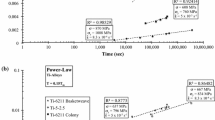Abstract
Isothermal creep, as well as the response to incremental stress and temperature changes, were studied in germanium single crystals oriented for double slip, in the range 470 to 700° C. The stress-sensitivity of the compressive creep rate δ In έ/δ In σ is numerically close to 3 at low strains, but increases appreciably with deformation. This effect, and a similar strain dependence of the activation energy as determined by thermal cycling, are explained in terms of the curvature of the creep curves on the basis of Boltzmann's superposition principle. The Peierls barrier seems to be an important obstacle to dislocation movement at relatively low temperatures, when S-shaped creep curves are observed. Other barriers, with greater heights, seem to become increasingly effective above about 550° C. Although dislocation loops, and the formation and break-up of dipoles were observed by TEM, recovery mechanisms involving self-diffusion did not appear to make a substantial contribution to the creep within the range of temperatures used.
Similar content being viewed by others
References
H. Alexander and P. Haasen, Solid State Physics 22 (1968) 27.
K. Berner and H. Alexander, Acta Metallurgica 15 (1967) 933.
H. Schaumburg, Phys. Stat. Sol. 40 (1970) K1.
V. I. Nikitenko, M. M. Myshlyaev, and V. G. Eremenko, “Dinamika Dislokatsii” (Ak. Nauk. Ukr. SSR, Kharkov, 1968) p. 84.
J. R. Patel and P. E. Freeland, J. Appl. Phys. 42 (1971) 3298.
P. Feltham, Phys. Letts. 33A (1970) 239.
L. Gerward, Phys. Stat. Sol. 2a (1970) 797.
F. Calzecchi, A. Gardini, and P. Gondi, Nuovo. Cim. 50 (1967) 263.
V. F. Miuskov, “Dinamika Dislokatsii” (Ak. Nauk. Ukr. SSR, Kharkov, 1968) p. 204.
M. M. Myshlyaev, V. I. Nikitenko, and V. I. Nesterenko, Phys. Stat. Sol. 36 (1969) 89.
R. Wagatsuma, K. Sumino, W. Uchida, and S. Yamamoto, J. Appl. Phys. 42 (1970) 222.
K. Kojima and K. Sumino, Crystal Lattice Defects 2 (1971) 147, 159.
D. B. Holt and A. E. Dangor, Phil. Mag. 8 (1963) 1921.
V. G. Govorkov, V. L. Indenbom, V. S. Papkov, and V. R. Regal, Sov. Phys. Sol. State 6 (1964) 802.
R. L. Bell and W. Bonfield, Pail. Mag. 9 (1964) 9.
P. Feltham, ibid 21 (1970) 765.
R. Labusch, Festkörperphysik 8 (1968) 268.
P. Feltham, Phys. Stat. Sol. 30 (1968) 135.
D. Brown, G. Chaudhri, and P. Feltham, Phil. Mag. 24 (1971) 213.
G. Chaudhri, Ph.D. Thesis (Brunel University, London 1971) p. 14.
B. A. Irving, Brit. J. Appl. Phys. 12 (1961) 92.
G. R. Booker, and R. Stickler, ibid, 13 (1962) 446.
M. M. Shea, L. E. Hendrickson, and L. A. Heldt, J. Appl. Phys. 37, (1966) 4572.
P. Feltham and G. Chaudhri, Phys. Stat. Sol. 7a (1971) K59.
N. Balasubramanian and J. C. M. Li, J. Mater. Sci. 5 (1970) 434.
P. Haasen, J. de Physique 27 (1966) C3–31.
Author information
Authors and Affiliations
Rights and permissions
About this article
Cite this article
Chaudhri, G., Feltham, P. Creep of germanium. J Mater Sci 7, 1161–1167 (1972). https://doi.org/10.1007/BF00550199
Received:
Accepted:
Issue Date:
DOI: https://doi.org/10.1007/BF00550199




